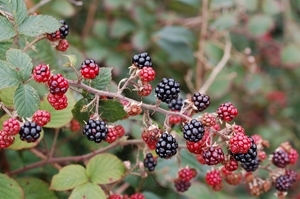Bramble (Rubus fruticosus agg.)
 I really like brambles! Even though they can be a real pain when they invade the garden and scratch you when you try to clear them, brambles have many attributes – honestly they do!
I really like brambles! Even though they can be a real pain when they invade the garden and scratch you when you try to clear them, brambles have many attributes – honestly they do!
Let me start with the most obvious plus that this plant offers – blackberries! What a wonderful way to spend a Sunday afternoon in the autumn, slowly wandering along a bramble-clad hedge, maybe with ageing grandparents and young children, chatting away while carefully plucking the tasty berries from the thorn covered bushes. Returning home with a punnet overflowing with blackberries is such a pleasurable experience, surely in built in us all from a history of hunter gathering. In fact blackberries have formed part of the human diet in Western Europe for thousands of years, as demonstrated by the discovery a perfectly preserved body in a bog in Jutland, Denmark, dating from around 490 BC (known as the Haraldskaer woman), which indicated that blackberries formed part of her diet.
Do make sure however, that you pick your berries before the 29th of September – St. Michael’s day, as some people believe that when Satan was cast out of heaven on this day, he landed in a prickly bramble bush, and for this reason he curses the plant by spitting (and worse!) on the berries, making them sour and inedible after this date!
We are not the only ones to enjoy blackberries, as many birds and mammals benefit from finding the ripening fruit. In fact, it becomes most noticeable at this time of year that most fox scats that you come across are purple in colour, stained by the juice of blackberries.
I keep calling the fruit of the bramble “berries”, but in a strict botanical sense, the blackberry is not a berry. Each tiny juicy ‘blob’ on the blackberry represents a tiny fruit or drupelet, and as there are many of them, it is actually an aggregate fruit. (A drupe is a fruit that has a fleshy, outer part that surrounds a stone or seed; a drupelet is a tiny drupe.)
Without close inspection, any given bramble simply looks like all other bramble plants, but in fact there are many micro-species of bramble, maybe up to 400 different ones in the UK, which is why it is known as an aggregate species and is written in Latin as Rubus fruticosus agg.
Along with the blackberry gathering season, the other time I particularly take notice of the plant is when it is in flower, as it is a fabulous nectar source for many insect species. If I want to know what butterflies frequent a wood, I will find myself a large sprawling bramble bush in full flower, situated in a sunny glade and settle down to let the butterflies come to me. Species such as the silver washed fritillary and the white admiral will soon appear if they are nearby, and feed on the flowers alongside numerous different types of bumblebee and hoverfly.
Deer love to browse bramble and in areas where they exist in high densities, they can actually limit the amount of bramble present in a wood. If the area of bramble is allowed to flourish however, it can grow into an almost impenetrable thicket, reaching head height and offering great shelter for many types of wildlife. Come the spring, it makes an ideal place for early nesting birds such as the song thrush to conceal her nest.
So, the bramble is a tremendous plant in my opinion, a view that is completely confirmed when I sit down at the table in mid winter with family and friends, to tuck into a large blackberry pie, collected for free one Sunday afternoon, back in the mellow autumn sunshine.
Peter Thompson
Advisory
Read more from Peter Thompson at the Fresh from the Field blog.

Download Peter Thompson's essential 26-page book, featuring beautiful photography and detailed profiles of Britain's wildlife
Download FREE >